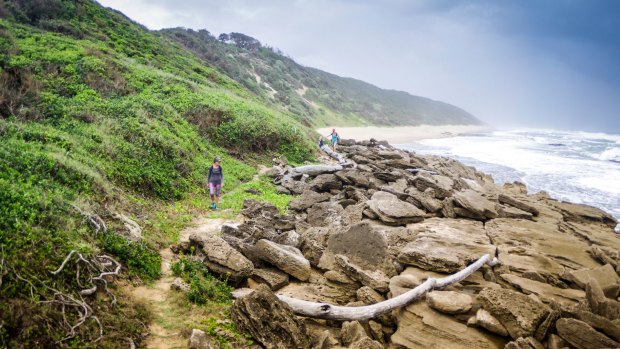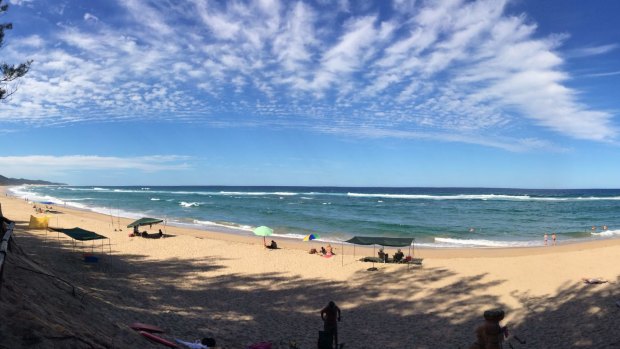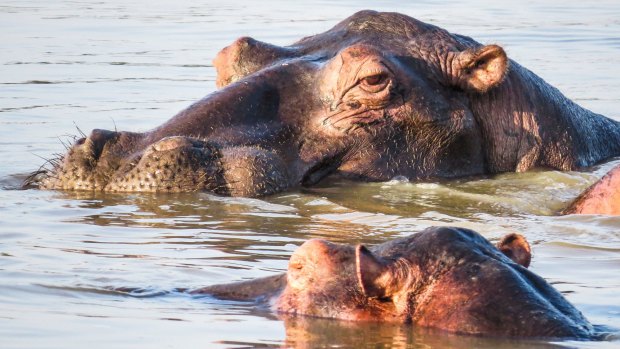This was published 4 years ago
iSimangaliso: One of South Africa's largest and wildest protected places
By Alison Stewart

Mission Rocks.Credit: Jacques Marais
There are various degrees of peace, beginning with city peace, which is a contented quiet underwritten by the gentle hum of urban life. At the other end of the spectrum, there's the deep, almost troubling peace of a pristine place, a layered stillness devoid of human sound. This is South Africa's iSimangaliso Wetland Park.
It helps to be intrepid when visiting one of South Africa's largest and wildest protected places, the Zulu name of which means miracle. The 358,534-hectare World Heritage area runs down the country's east coast from close to the border of Mozambique and accounts for about 9 per cent of the country's coastline.

Cape Vidal.Credit: iSimangaliso Tourism
It encompasses diverse habitats and landscapes, including its"10 jewels": Coastal Forest, Eastern Shores and Cape Vidal (beaches and safari opportunities), False Bay, Kosi Bay, Lake Sibaya, Lake St Lucia, Maphelane, Sodwana Bay, Mkuze, Western Shores and Charters Creek. These diverse regions support astonishing numbers of animal and plant species, including 530 bird species.
This is self-drive country, a place where sand and mud threaten to bog vehicles, where hippos – South Africa's most lethal animal – roam relatively unimpeded. Out there in the darkness, away from the few areas of "civilisation", iSimangaliso, also known as the Greater St Lucia Wetland Park, positively writhes with wildlife.
Walk to the edge of an estuary – Nile crocodiles slither around you. Gaze out over a lake – hippos chug territorially. Poke a toe in the ocean – Zambezi (bull) sharks lurk. Peer through undergrowth – elephant and Cape buffalo wallow. Tread gingerly through grass – KwaZulu-Natal's poisonous green mamba snake slithers away. Swim at Cape Vidal – thickets of hand-sized, tangerine-coloured crabs occasionally hog the waves. That vine you were admiring unfurls into a twig snake for which there is no antivenom.

Hippo Lake, St LuciaCredit: iSimangaliso Tourism
Do not walk into the garden at night, warns our St Lucia host. Hippos are deadly, travelling up to 15 kilometres a night to graze. Danger: crocodiles, sharks and hippos, counsel the signs. Other signs at lookouts and boardwalks warn that you leave your car at your own risk.
And yet, this is a rare paradise. ISimangaliso contains three major lake systems, eight interlinking ecosystems, most of South Africa's remaining swamp forests, Africa's largest estuarine system, a 25,000-year-old coastal dune system that is among the highest in the world and the big seven – humpback whales and whale sharks join lion, rhino, elephant, leopard and Cape buffalo.
In Nelson Mandela's words, "iSimangaliso must be the only place on the globe where the oldest land mammal, the rhinoceros, and the world's biggest terrestrial mammal, the elephant, share an ecosystem with the world's oldest fish, the coelacanth, and the world's biggest marine mammal, the whale."
My partner and I have come to this place of miracles on a driving adventure, though we quickly realise our sedan car is inadequate. To properly access swaths of this wild territory, particularly the northern Coastal Forest region, you need a 4WD. We make do, though there is a bogging, and the car emerges battered, muddy and insect-caked.
We drive about six hours from Johannesburg, staying en route at the Big 5 Hluhluwe-Imfolozi Park, South Africa's oldest proclaimed game reserve. The park, originally the Zulu kingdom's royal hunting grounds, is credited with rescuing the white rhino from extinction. We see a white rhino family with baby in the rugged mountainous northern section.
From Hluhluwe, we drive the 75 kilometres to St Lucia town where our iSimangaliso adventure begins. Our hilltop Airbnb – which is unairconditioned (avoid the area in summer, this is humid, tropical country) – has vintage decor and is perfect for its gorgeous views of nature reserve, estuary and ocean. African pied wagtails and trumpeter hornbills soar overhead, golden-tailed woodpeckers rat-a-tat, hippos backfire, mongooses peek around cycads, duikers graze the lawn and the surf thunders.
ISimangaliso's wildness also seeps into St Lucia. Mongooses, vervet monkeys, duikers, bushbucks and, most alarmingly, hippos roam the streets and wander into gardens. Hippo warning signs are to be taken seriously. In 2012, a large bull hippo seriously injured a man in his garden.
The scale of the park means our week is inadequate. The locals know this. They arrive in their 4WDs, stock up on water and supplies, then melt away for weeks into the many pristine areas to fish, dive, rock-hop, camp and recharge. We try following them, driving up to the Mozambique border.
But these rough northern roads require more grunt. We tackle the road in to Kosi Bay hoping to reach the four-lake complex and estuarine basin that opens to the sea. The Kosi River mouth – a fish and birding paradise – is dubbed "the aquarium" and traditional Tsonga woven fish traps and palisade fish kraals have been used there for more than 700 years. No luck for us. The last 45 kilometres is strictly 4WD and you need a permit. We will return, better prepared.
ISimangaliso is huge and its heart is the estuary system.
An estuary cruise introduces us to the place where more than half of KwaZulu's water birds feed, roost and nest. Of the 155 fish species recorded here, 71 use Lake St Lucia as a nursery. There are more than 2180 species of flowering plants and the waters sustain antelope such as waterbuck, reedbuck, kudu, impala, nyala and duiker. Five rivers nourish the lake that nourishes a miraculous world.
Our cruise guide introduces us to this mangrove and reed-lined place, interpreting the hippos' grumbles for us, identifying a swimming black mamba/Mozambican spitting cobra. We see a rare pair of African fish eagles, bird and plant species such as the ostrich-shaped wild cabbage tree, and basking crocodiles. We examine the mangroves carefully before disembarking.
The fenced lake edges are a tale of two shores – the coastal eastern side boasts marine species such as humpback whales, dolphins, rare turtles, whale sharks, marlin and sailfish, also Cape buffalo, zebra, elephant, rhino, hippo, hyena, warthogs and antelope. The Western Shores, with half the east's rainfall, are all about the estuary and drier, raptor-rich palmveld.
Enter the Eastern Shores when the gates open for good game sightings. The sun colours the sky as we immediately spot Cape buffalo, kudu, nyala and warthog. Various off-road loops past freshwater pans treble our sightings.
At Cape Vidal beach, the big-game fishing boats are launching, timing their tricky surf entries. In season, humpback whales approach shore on their migration north to Mozambique.
The Western Shores were once degraded forestry plantations but the removal of thousands of hectares of alien trees has rehabilitated the landscape. Historic game such as elephant, serval, tsessebe, giraffe, nyala, white and black rhino, buffalo, zebra, wildebeest, and red and grey duiker have been reintroduced.
The loop roads offer elephant and buffalo wallowing, herds of zebra and giraffe, eland, kudu, warthog and too many unusual birds to number. No leopard on our visit, sadly. We discover a true taste of iSimangaliso's deep peace at Charters Creek at the Western Shores' northernmost accessible point.
We arrive to the rare sight of a massive African crowned crane sunning itself on the jetty. In our haste to snap a photo, we inadvertently invade the 30-metre personal space of a pod of hippos, which erupt in a cacophony of chugs. We beat a hasty retreat – these animals can stampede at 50 kilometres an hour.
False Bay is a red-soil green world of tamboti trees and acacia, opening into Lake St Lucia. This is where we bog, navigating the water's edge, while nyala, warthog and guinea fowl, maybe even leopard, are doubtless chuckling at us from the looming sand-forest which is dense with leadwood, marula, Zulu podberry and torchwood.
Finally, in this place of miracles, we discover another, more worldly miracle – excellent flat whites at Kauai in St Lucia town. Perfect for a post-game drive brekkie stop.
FIVE MORE ST LUCIA MIRACLES
THE MAPHELANE DUNE
South Africa's highest vegetated dune is at the south end of the Lake St Lucia Estuary basin and soars 183 metres. Hike to the viewpoint for breathtaking views of the ocean and Imfolozi River mouth.
LAKE SIBAYA
The birding paradise of Lake Sibaya is southern Africa's largest freshwater lake, tucked against forested coastal dunes parallel to the iSimangaliso coastline. No rivers flow in or out of the lake, which contains KwaZulu's second-largest hippo and crocodile populations.
TURTLE ENCOUNTERS
The vast iSimangaliso beaches host endangered leatherback and loggerhead turtles, which come ashore from November to March to lay eggs. Evening tours are available from St Lucia and Cape Vidal.
THE SYCAMORE FIG FOREST
Africa's only unspoiled indigenous fig forest of its kind is on the banks of the Mkuze River. Some trees are more than 400 years old. The birdlife is remarkable as the figs bear fruit all year.
SODWANA BAY
Its coral reef is one of the world's top 10 dive destinations and has more than 1200 species of fish. It is home to the coelacanth, which was discovered offshore in the deep Jesser Canyon in 2000. It was thought to have become extinct with the dinosaurs 65 million years ago but was discovered in 1938.
St Lucia Holiday Cottage is a three-bedroom, three bathroom Airbnb property that can sleep up to nine. From $197 a night. See airbnb.com.au/rooms/16789796
FLY
Qantas flies daily from Sydney to Johannesburg. See qantas.com
Alison Stewart travelled at her own expense.
Sign up for the Traveller Deals newsletter
Get exclusive travel deals delivered straight to your inbox. Sign up now.